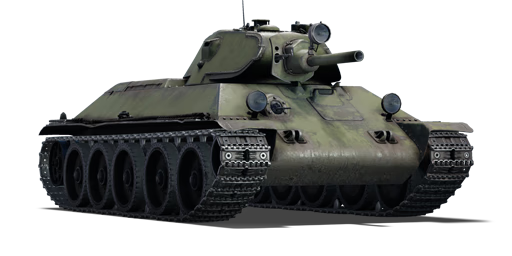


The A-34 (otherwise known as T-34 (Prototype)) was the precursor of the famous T-34 medium tank that played a crucial role in the Soviet victory in the Second World War. The A-34 was developed from 1937 to 1939 by the design bureau of Kharkiv Factory No. 183, led by Mikhail Koshkin. It was based on the earlier BT-7M tank, but with a new welded hull and a sloped armour of 45 mm on the front and 40 mm on the sides. The A-34 was armed with a 76 mm L-11 gun and two 7.62 mm machine guns, one in the hull and one in the turret. The A-34 prototype underwent extensive testing in 1939 and 1940, proving its superior mobility, firepower and protection compared to other Soviet tanks at the time. On 19 December 1939, the Defence Committee of the Council of People's Commissars of the USSR decided to adopt the A-34 as the T-34, with some modifications such as improving visibility and installing additional machine guns. The T-34 entered mass production in 1940 and became one of the most influential tanks in history.
The A-34, or the T-34 prototype was available only for pre-order during the Closed Beta Test of Ground Forces before Update 1.41, then discontinued after the update's release. 500 units were also for sale during the 5th Anniversary event, which sold out within 12 hours. It has the same features as other T-34s, such as high speed, a decent 76 mm L-11 gun, and 45 mm sloped armour. These make it good for flanking and brawling. The front has weak spots that can be penetrated, but a fast and aggressive style can minimize the exposure. The T-34 prototype differs from the T-34 (1940) in some details, such as a canvas on the left hull, a light on the gun, and an antenna on the turret. Several noticeable weak points on the T-34 are the turret cheeks, the step and the machine gun port on the front hull, and the turret ring. These areas have less sloping or thinner armour than the rest of the tank, making them vulnerable to enemy fire.
| Ammunition | Type | Armor penetration (mm) at a distance: | |||||
|---|---|---|---|---|---|---|---|
| 10 m | 100 m | 500 m | 1000 m | 1500 m | 2000 m | ||
| APHEBC | 77 | 76 | 69 | 62 | 55 | 49 | |
| HE | 11 | 11 | 10 | 10 | 10 | 10 | |
| Shrapnel | 35 | 34 | 30 | 25 | 22 | 18 | |
| APBC | 90 | 88 | 79 | 69 | 60 | 52 | |
| Belt | Belt filling | Armor penetration (mm) at a distance: | |||||
|---|---|---|---|---|---|---|---|
| 10 m | 100 m | 500 m | 1000 m | 1500 m | 2000 m | ||
| AP-I/API-T | 13 | 12 | 7 | 3 | 2 | 0 | |







 2 x (40 / 50 / 60) %
2 x (40 / 50 / 60) % 
 2 x 118 %
2 x 118 % 

Mobility | |
|---|---|
Protection |
|---|
Firepower | |
|---|---|